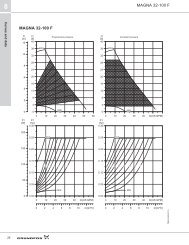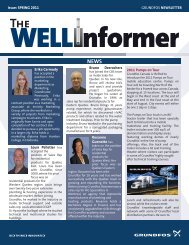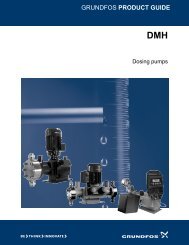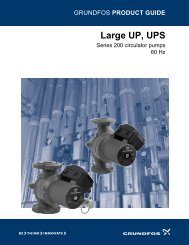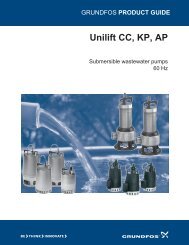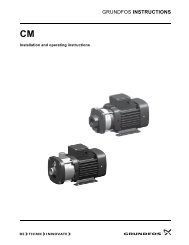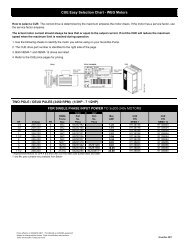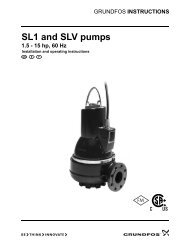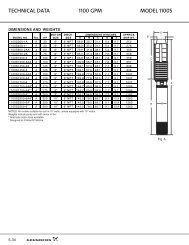Create successful ePaper yourself
Turn your PDF publications into a flip-book with our unique Google optimized e-Paper software.
<strong>Grundfos</strong> E-<strong>pumps</strong><br />
2<br />
Such a pumping system can be designed in two ways:<br />
• The differential-pressure transmitter (DPT 1 in<br />
fig. 16) is placed across the pump, and the system<br />
is running with proportional differential-pressure<br />
control.<br />
• The differential-pressure transmitter (DPT 2 in<br />
fig. 16) is placed close to the radiators, and the<br />
system is running with proportional differential<br />
pressure control.<br />
The advantage of the first solution, which is equal to<br />
a TPE Series 2000 pump solution, is that the pump,<br />
PI controller, speed control and transmitter are placed<br />
close to one another, making the installation easy.<br />
This solution makes it possible to get the entire system<br />
as one single unit. In order to get the system up and<br />
running, pump curve data must be stored in the<br />
controller. These data are used to calculate the flow<br />
and likewise to calculate how much the setpoint, H set ,<br />
has to be reduced at a given flow to ensure that the<br />
pump performance meets the requirements.<br />
The second solution involves higher installation costs<br />
as the transmitter has to be fitted near the radiators<br />
and extra cabling is required. The performance of this<br />
system is more or less similar to the first system. The<br />
transmitter measures the differential pressure at the<br />
radiator and the PI controller compensates<br />
automatically for the increase in required pressure in<br />
order to overcome the increase in pressure losses in<br />
the supply pipes, etc.<br />
PI controller<br />
The MLE has a built-in PI controller for speed control<br />
of <strong>pumps</strong>. The factory setting of gain (Kp) and integral<br />
time (Ti) can easily be changed. The controller can<br />
operate in both normal and inverse mode.<br />
Normal mode<br />
Normal mode is used in systems in which an increase<br />
in pump performance will result in a rise in the value<br />
measured at the feedback sensor. This will typically be<br />
the case in most MLE applications.<br />
Normal mode is selected by setting the gain (Kp) to a<br />
positive value in the control panel.<br />
Inverse mode<br />
Inverse mode is used in systems in which an increase<br />
in pump performance will result in a drop in the value<br />
measured at the feedback sensor. This mode will<br />
typically be used for constant level operation (filling a<br />
tank) and for constant temperature operation in cooling<br />
systems.<br />
Inverse mode is selected by setting the gain (Kp) to a<br />
negative value in the control panel.<br />
System/application<br />
p<br />
L [m]<br />
p<br />
p<br />
t<br />
t<br />
Q<br />
L [m]<br />
L [m]<br />
L [m]<br />
t<br />
Heating<br />
systems<br />
<br />
K p<br />
0.5<br />
0.5<br />
Cooling<br />
system<br />
<br />
T i<br />
0.5<br />
L 1) < 16.4 ft: 0.5<br />
L > 16.4 ft: 3<br />
L > 32.8 ft: 5<br />
0.5 0.5<br />
0.5 0.5<br />
0.5 –0.5 10 + 1.52L<br />
0.5 10 + 1.52L<br />
0.5 –0.5 30 + 1.52L<br />
+2.5 100<br />
Heating systems are systems in which an increase in pump<br />
performance will result in a rise in temperature at the sensor.<br />
Cooling systems are systems in which an increase in pump<br />
performance will result in a drop in temperature at the sensor.<br />
L) Distance in [ft] between pump and sensor<br />
Product overview<br />
19



